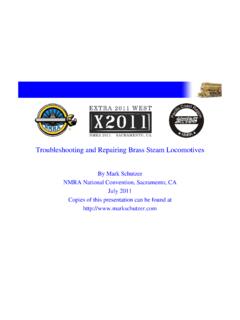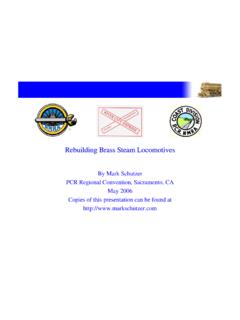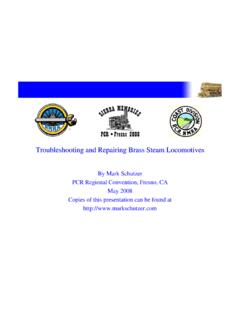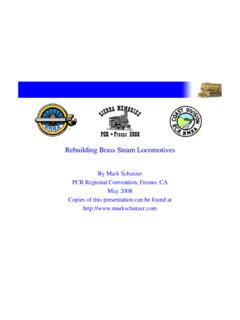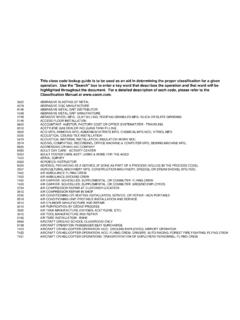Transcription of R b ildi B S L iRebuilding Brass Steam Locomotives
1 R b ildiBSLiR b ildiBSLiRebuilding Brass Steam LocomotivesRebuilding Brass Steam LocomotivesBy Mark SchutzerNMRA National Convention, Sacramento, CAJuly 2011 Copies of this presentation can be found OverviewsClinic OverviewsRebuilding Steam Locomotives This clinic will show you how to turn those noisy growlers into prize runners that will silently creep down the track. Re-motoring diill b didd ill t t d i d t ilTiand re-gearing will be discussed and illustrated in detail. Topics include motor and gearbox selection, motor mount construction, and the use of universal joint couplings. July 2011 rebuilding Brass Mark Schutzer2 The tale of three KTM tale of three KTM quick little demonstrationMountain 4355 Original condition, as obtainedPacific 2467 Aftl tif li i After completion of clinics Re-motored Re-geared Universal couplingU ve sa coupg Decoder equippedMountain 4353 After completion of clinics Re-motored Re-geared Universal couplingDdidJuly 2011 rebuilding Brass Mark Schutzer3 Decoder equippedProblem AreasProblem AreasMotorsMotorsGearboxesRigid motor to gearbox couplingsJuly 2011 rebuilding Brass Mark Schutzer4 Motor IssuesMotor IssuesMotor Issues Most early (1950 s through mid 1970 s) Brass Locomotives are equipped with open frame motors.
2 Most of these motors have very poor starting torque resulting in a higher Most of these motors have very poor starting torque resulting in a higher starting voltage. As a result it is almost impossible to get slow prototypical starting of a locomotive . The increased starting voltage causes the locomotive to lurch li iOihlbddlhto a unrealistic start. Once running the voltage can be reduced to slow the locomotive down, but it won t run well due to the poor slow speed torque of the motor. These motors are very inefficient by today s standards and consumed lots yyyof current. Typical stall currents for these motors are in the range of two amps or more. These high stall currents are not compatible with HO scale DCC decoders. As a result of the higher running speed of these motors large gearboxAs a result of the higher running speed of these motors large gearbox reduction ratio s (37:1 or greater) are typically used.
3 At higher locomotive speeds this results in noisy operation in part due to the high operating speed of motor and 2011 rebuilding Brass Mark Schutzer5 Original MotorsOriginal MotorsSome typical open frame motor numbersMotor TypeOpen FrameFree RunningCurrent (Amps)Typical loadedCurrent (Amps)Stall Current(Amps)Open FrameKTMC urrent (Amps)12 voltsCurrent (Amps)12 volts(Amps)12 or or or more> 2011 rebuilding Brass Mark Schutzer6 Gearbox IssuesGearbox IssuesGearbox issues Most early gearboxes run noisy due to large space tolerances between the gears. The early square cut worms are inherently noisy. A lot of the early bdbthtl dtldthtlgearboxes used both steel worms and steel worm gears, and the steel on steel also resulted in noisier operation. Many original gearboxes have high reduction ratios to make up for poor motor performance The higher operating speeds also cause noisymotor performance.
4 The higher operating speeds also cause noisy operation. A lot of the earlier models use open gearboxes, or open gears which are both noisy and messy as the lubrication ended up all over. A lot of early gearboxes are poorly made and just don t work well. A modern precision made gearbox should run nearly silent, even at high locomotive speedsJuly 2011 rebuilding Brass Mark Schutzer7 Coupling IssuesCoupling IssuesRigid motor to gearbox couplings Most early Brass Locomotives make use of a piece of plastic or rubber tubing to ltht tthbcouple the motor to the gearbox. This tubing forms a rigid coupling between the motor and the gearbox. The basic issue is gearbox motion Up and down motion due to sprung axles. Side to side motion due to axle shifting on curves. Motion due to residual wobble.
5 The rigid coupling restricts the free motion of the gearbox causing noise dbi diand 2011 rebuilding Brass Mark Schutzer8 Coupling IssuesCoupling IssuesOpen worm on motor shaft Another common technique used on early Locomotives had the worm soldered directly on the motor shaft. An open worm gear was used on the dil Thtt dhth tthdriven axle. The motor was mounted such that the open worm was suspended above and in contact with the worm gear. Common with un-sprung drivers. There are a few problems with this scheme first it is difficult to maintain There are a few problems with this scheme, first it is difficult to maintain proper worm to gear mesh, the open gears are noisy, and you can t properly lubricate the gears without oil, and or grease flying all over the place. July 2011 rebuilding Brass Mark Schutzer9 Coupling IssuesCoupling IssuesMetal Universals Many of the larger old articulated Locomotives used metal universal joints in portions of their drivelines.
6 These old metal parts ran noisy, and sometimes only a single ball and cup joint would be used, requiring critical alignment to work without 2011 rebuilding Brass Mark Schutzer10 RebuildingRebuildingRebuilding OverviewRebuilding OverviewMotorsMotor MountsMotor MountsGearboxesDrivers and GearsDrivers and GearsCoupling MethodsTorque ArmsFlywheelsBalancingJuly 2011 rebuilding Brass Mark Schutzer12 MotorsMotorsCan motor advantages More efficient, much lower current draw Most are skew wound for very good slow speed performance Slower starting speeds and excellent slow speed torque Better slow speed performance allows lower gearbox ratios to be used reducing the top end noise. DCC friendly; isolated terminals, and most HO sized motors have stall currents under or about 1 the largest size motor that will fit in the flat can types when your firebox area is motors to choose NWSL Sagami Mashima A line Proto Power West CannonJuly 2011 rebuilding Brass Mark Schutzer13 MotorsMotorsCan motor selectionJuly 2011 rebuilding Brass Mark Schutzer14 Can MotorsCan MotorsSome typical can motor numbersMotor TypeNWSLFree RunningCurrent (Amps)Max.
7 ContinuousCurrent (Amps)Stall Current(Amps)Stall Torque (Oz-in )NWSLC urrent (Amps)12 voltsCurrent (Amps)12 volts(Amps)12 volts( ) 2011 rebuilding Brass Mark Schutzer15 Motor MountsMotor MountsMotor Mounting The new motor needs to be installed and secured to the locomotive s frame. Motor needs to be removable for servicing. Mount should allow for minor adjustments in the motor position. Mount should provide for some isolation of the motor s vibration Mount should provide for some isolation of the motor s Universal motor cradle fabricated from Brass . Motor attached to cradle with Silicon Rubber sealant. Motor cradle attached to frame with the original motor mountingMotor cradle attached to frame with the original motor mounting 2011 rebuilding Brass Mark Schutzer16 Motor CradlesMotor CradlesMotor Cradle fabrication Base made from.
8 062 x .5 Brass bar stock. Sides made from .125 x .125 angle stock. Solder together. Drill and tap hole in the base to line up with hole in frame. Milled version as alternativeas alternativeJuly 2011 rebuilding Brass Mark Schutzer17 GearboxesGearboxesReplacement Gearboxes A large selection of precision gearboxes available from NWSL. Standard gear ratios of 28:1 and 36:1 M tHO i03dflllti04df Most common HO sizes; mod for small Locomotives , mod for medium to large Locomotives Non idler, Idler, Double Idler, and High/Low types available All precision machined gears for silent operationp ec s oaced gea s o s e t ope at oTips Read the instructions carefully the first Sand gearbox bottom to eliminate excess axle play. Run a tap through all the holes to make it easier to install the screws.
9 Make sure that worm shaft bearings are snug in gearbox. You may have td littl bit f tf thbh ltto sand a little bit of a taper on one of the gearbox halves to assure snug worm shaft bearings for some gearbox models. See assembly tutorial write-up on my websiteJuly 2011 rebuilding Brass Mark Schutzer18 GearboxesGearboxesNew Gearbox ChoicesJuly 2011 rebuilding Brass Mark Schutzer19 Pulling Drivers and GearsPulling Drivers and GearsNWSL PullerArbor Press NWSL Sensipress PanaVise pressPanaVise pressJuly 2011 rebuilding Brass Mark Schutzer20 Pressing GearsPressing GearsArbor Press NWSL Sensipress PanaVise pressNWSL Gear AlignersJuly 2011 rebuilding Brass Mark Schutzer21 Quartering ToolsQuartering ToolsNWSL QuartererNWSL Quarterer 2 Quartering viseJuly 2011 rebuilding Brass Mark Schutzer22 Pressing DriversPressing DriversQuarteringJuly 2011 rebuilding Brass Mark Schutzer23 Coupling MethodsCoupling
10 MethodsRubber Couplings Can successfully be used in some rigid torque arm applications, but motor to gear box alignment critical. Universal joints recommended shaft direct through gearbox Can be used in some applications. Eliminates alignment issuesEliminates alignment issues. Not practical for non idler gearboxes. Space issues, large motor close to joints Preferred method, but requires torque arm. Non rigid connection between motor and gearbox. Works well even with some misalignments, keep angles to under 15 degrees per joint. Runs very quiet. Isolates gearbox from motor. July 2011 rebuilding Brass Mark Schutzer24 Universal JointsUniversal JointsWide variety of choices available from sizes to support all the common shaft sizes; mm, mm, and shafting material also available from 2011 rebuilding Brass Mark Schutzer25 Torque ArmsTorque ArmsA torque arm is needed to keep the gearbox from rotating when using universal joint prefer an overhead torque arm with a pivot point at the motor Make from.
